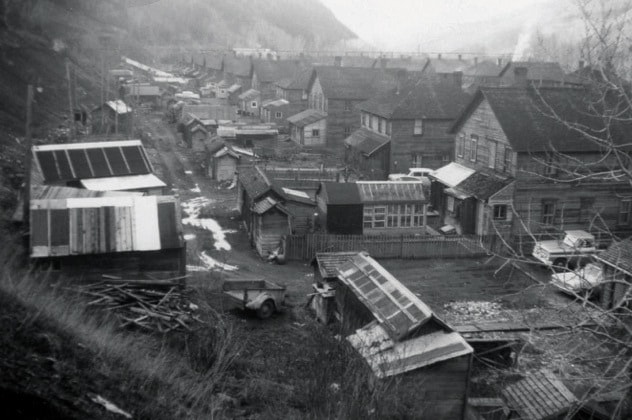To see her childhood home in the long gone community of Michel, Margaret Savilow needs to go to the museum.
“This was my parents’ house,” she said, pointing to a photo of an old home during the official opening of the Sparwood Museum at its new location. “This was the old post office I believe,” she said, pointing to others. “That’s the old hospital.”
Now that it's moved to 141B Aspen Drive, right next to Titan Park, the staff at the Sparwood Museum are hoping a locale will mean more visitors.
“Everything has worked out very well and we’re happy to be here,” said David Wilks, Chair of the Michel-Natal-Sparwood Heritage Society. “It’s a prime location. this is where all the tourists stop."
Since being founded in 1985 by a group of volunteers, the wandering museum has had two locations in Centennial Square and another by the old police station.
Last year about 70,000 people stopped to look at Sparwood’s Titan Truck. Wilks is hoping that at least 10 per cent of that number will drop by the adjacent museum. Seven thousand visitors a year would be a huge increase in visitation for the Sparwood Museum, he said.
Wilks also mentioned that the museum will now be charging visitors a fee of $2, where before entrance was by donation.
The museum is run by the Michel-Natal-Sparwood Heritage Society and contains pictures and artifacts from the now destroyed communities of Michel, Natal and Middletown. There are old photos, a desk from the elementary school, toys, home furnishings and mining equipment.
Michel was founded in 1903 and grew into the adjacent communities of Middletown and Natal. At their peak, the communities boasted about 1500 residents.
Coal mining brought residents to Michel-Natal where they built homes, lives and created communities for themselves and their families. Community spirit forged a sense of pride and closeness with their often times dirty and smoky hometown.
Monica Beranek, director of the Michel-Natal-Sparwood Heritage Society, was born in Michel and remembers it as a tight-knit community.
“It was carefree for us,” she said. “We never knew that we were poor, us coal mining families, because we lived the life of Riley.”
Beranek recalls playing with her friends on grass-covered slag heaps around the community and in the surrounding woods. In the community’s backyards there was “garden after garden,” she said.
In 1964 B.C. Minister of Municipal Affairs Dan Campbell announced that a joint venture by the federal and provincial governments was being undertaken to relocate Michel-Natal westward to Sparwood, which had been founded in the 1940s.
According to the Michel-Natal-Sparwood Heritage Society, the reason to relocate the town was to improve the health and living standards of Michel-Natal residents by moving them to a cleaner place. Michel-Natal was located right next to where the Elkview coal mine is today.
However, Wilks pointed out that the rundown coal-streaked buildings of Michel-Natal were undesirable for a government that was trying to promote tourism.
“The governments of the day decided it was not appealing for the first thing people to see when driving into the province was a coal mine with coking ovens,” he said.
The residents were to be compensated for their homes and property. They received anywhere from $4,000 to $5,000 and a 1965 plebiscite revealed that 95 per cent of the residents were in favour of the move but the notion that some residents were short-changed for their properties, remains a point of contention.
“What they received in compensation for their houses was not good,” said Wilks. “It left a bad taste in a lot of people’s mouths to this day.”
In addition, California based Kaiser Resources, which had just acquired the Elk Valley’s coal mines, wanted the land that the communities occupied in order to stockpile equipment and to create offices and warehouses for its new strip-mining operation.
Beranek recalls how a number of residents simply left the Elk Valley rather than accept relocation to Sparwood.
“We lost a lot of people, they went all over the place,” she said. “There were a lot of hard feelings.”
Savilow and her husband Bill – now married 55-years – were among those who decided to move to Sparwood but there were adjustments. No longer could they spend $9 a month on rent in Michel. Now they had a mortgage in Sparwood.
“Bill went to the mine and asked to be taken off a 100 tonne truck and put on a 200 tonne truck because that one paid 20 cents an hour more and we needed that 20 cents an hour to allow us to buy our home,” she said.
She still recalls how residents relocating to Sparwood would take all of their unwanted possessions and throw them in their cellars with the firm knowledge that they would be buried once their homes were destroyed by wrecking crews.
“We just opened up the cellar and threw in all the stuff because we knew it was going to be buried,” she said. “My dad had an old Model T car he didn’t want and it was in the back and it went in the ground. So if anyone wants to go look, it’s still out there somewhere I’m sure. Underground.”
Margaret has fond memories of growing up in Michel-Natal but pointed out that “We didn’t know any different of course. Kids nowadays might say how could you live there? Well, we had to live there. We had to make our own fun. We didn’t have television, we didn’t have computers and we didn’t have those fancy games but we were close. Everybody knew everybody.”
